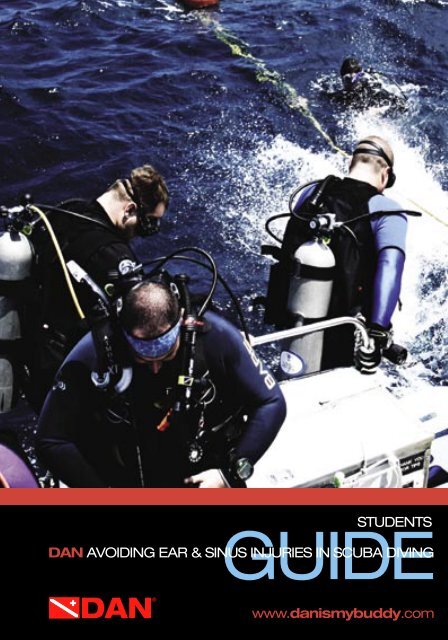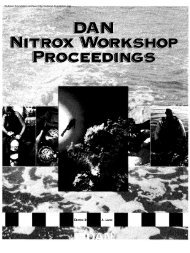dan avoiding ear & sinus injuries in scuba - Divers Alert Network
dan avoiding ear & sinus injuries in scuba - Divers Alert Network
dan avoiding ear & sinus injuries in scuba - Divers Alert Network
You also want an ePaper? Increase the reach of your titles
YUMPU automatically turns print PDFs into web optimized ePapers that Google loves.
STUDENTS<br />
GUIDE<br />
DAN AVOIDING EAR & SINUS INJURIES IN SCUBA DIVING<br />
www.<strong>dan</strong>ismybuddy.com
THE UPS AND DOWNS OF DIVING.<br />
STUDENTS<br />
GUIDE<br />
DAN AVOIDING EAR & SINUS INJURIES IN SCUBA DIVING<br />
As <strong>scuba</strong> divers, we must adapt to an<br />
environment that exerts pressure on<br />
our bodies. The most common <strong><strong>in</strong>juries</strong><br />
reported to <strong>Divers</strong> <strong>Alert</strong> <strong>Network</strong> (DAN)<br />
each y<strong>ear</strong> <strong>in</strong>volve pressure-related<br />
<strong><strong>in</strong>juries</strong> to divers’ <strong>ear</strong>s and <strong>s<strong>in</strong>us</strong>es. A<br />
little education and common sense will<br />
go a long way to avoid these problems.<br />
Take a m<strong>in</strong>ute to read this brochure. DAN, your dive store and your <strong>in</strong>structor want<br />
your <strong>scuba</strong> adventures to be enjoyable and safe.<br />
SINUS AND MIDDLE EAR INJURIES<br />
Barotrauma is a pressure-related <strong>in</strong>jury. Middle <strong>ear</strong> barotrauma, known as “<strong>ear</strong><br />
squeeze,” is the most common div<strong>in</strong>g <strong>in</strong>jury. S<strong>in</strong>us barotrauma also occurs, but it is<br />
less common.<br />
How does it happen? Barotrauma is caused by pressure changes when div<strong>in</strong>g.<br />
Dur<strong>in</strong>g descent, air spaces <strong>in</strong> the <strong>s<strong>in</strong>us</strong>es and middle <strong>ear</strong> must be able to equalize<br />
to the surround<strong>in</strong>g water pressure, which <strong>in</strong>creases with depth. When pressure <strong>in</strong><br />
air spaces can’t equalize because swollen or damaged tissue restricts air passage<br />
through the open<strong>in</strong>gs that allow equalization, the diver may sense pressure or pa<strong>in</strong><br />
from one of these areas. Dur<strong>in</strong>g ascent, if the expand<strong>in</strong>g air can’t be vented, the<br />
cavity pressure <strong>in</strong>creases, result<strong>in</strong>g <strong>in</strong> discomfort.<br />
This type of <strong>in</strong>jury can range <strong>in</strong> severity, from mild to extreme. A <strong>s<strong>in</strong>us</strong> or middle <strong>ear</strong><br />
<strong>in</strong>jury may occur suddenly and lead to significant damage. For this reason, divers<br />
should know and use the “cl<strong>ear</strong><strong>in</strong>g,” or equaliz<strong>in</strong>g, maneuver that works best<br />
for them.<br />
1<br />
www.<strong>dan</strong>ismybuddy.com
THE UPS AND DOWNS OF DIVING.<br />
STUDENTS<br />
GUIDE<br />
DAN AVOIDING EAR & SINUS INJURIES IN SCUBA DIVING<br />
HOW TO EQUALIZE<br />
The ma<strong>in</strong> th<strong>in</strong>g to remember is to beg<strong>in</strong> to equalize <strong>ear</strong>ly; start on the surface with<br />
a gentle Valsalva maneuver. At the first h<strong>in</strong>t of a problem the descent should be<br />
stopped until you have equalized. If equalization is not possible, it may be helpful<br />
to ascend to a shallower depth and reattempt the process us<strong>in</strong>g a slower approach<br />
or a different technique. Equalization becomes more difficult as the pressure<br />
gradient between the middle <strong>ear</strong> and the environment <strong>in</strong>creases. Gentle, frequent<br />
equalizations are more effective and less likely to cause damage than forceful<br />
equalization, especially after significant pa<strong>in</strong> has occurred.<br />
THE VALSALVA MANEUVER<br />
In probably the most commonly taught method, the diver closes the mouth,<br />
p<strong>in</strong>ches the nose and blows gently.<br />
Avoid blow<strong>in</strong>g too hard and over<strong>in</strong>flat<strong>in</strong>g the middle <strong>ear</strong> space. This can occur if<br />
the diver is overly excited or hav<strong>in</strong>g a difficult time equaliz<strong>in</strong>g dur<strong>in</strong>g descent, and<br />
especially if he has waited too long before attempt<strong>in</strong>g to equalize. The result could<br />
be <strong>in</strong>jury to the middle or <strong>in</strong>ner <strong>ear</strong>.<br />
THE FRENZEL MANEUVER<br />
This method is similar to the Valsalva maneuver, except that <strong>in</strong>stead of blow<strong>in</strong>g<br />
air <strong>in</strong>to the <strong>s<strong>in</strong>us</strong>es, the diver closes the nose and mouth and drives the tongue<br />
backward on the roof of the mouth. The muscle contraction opens the nasal<br />
cavities and Eustachian tube, which allows air <strong>in</strong>to the middle <strong>ear</strong>.<br />
THE YAWN & SWALLOW MANEUVER<br />
Some divers can simply swallow, yawn or thrust the lower jaw forward and open<br />
the mouth while us<strong>in</strong>g the lips to ma<strong>in</strong>ta<strong>in</strong> a seal with the regulator mouthpiece.<br />
This opens the Eustachian tube to the middle <strong>ear</strong>, which equalizes pressure.<br />
As long as the <strong>s<strong>in</strong>us</strong>es also equalize easily, this maneuver is acceptable.<br />
For many divers, a comb<strong>in</strong>ation of these methods — even switch<strong>in</strong>g back and forth<br />
dur<strong>in</strong>g a s<strong>in</strong>gle descent — works best. S<strong>in</strong>ce the ostia, or open<strong>in</strong>gs, to the <strong>s<strong>in</strong>us</strong>es<br />
are normally open cont<strong>in</strong>uously, <strong>s<strong>in</strong>us</strong> equalization normally does not require any<br />
special maneuvers. Pa<strong>in</strong> <strong>in</strong> the forehead or cheek dur<strong>in</strong>g descent usually <strong>in</strong>dicates<br />
that there is some obstruction <strong>in</strong> the <strong>s<strong>in</strong>us</strong> ostium, and the dive should be aborted.<br />
2<br />
www.<strong>dan</strong>ismybuddy.com
THE UPS AND DOWNS OF DIVING.<br />
STUDENTS<br />
GUIDE<br />
DAN AVOIDING EAR & SINUS INJURIES IN SCUBA DIVING<br />
PREVENTION IS THE KEY<br />
The most common reason for divers to suffer barotrauma is a failure to <strong>in</strong>flate<br />
the <strong>ear</strong>s and <strong>s<strong>in</strong>us</strong>es with additional air dur<strong>in</strong>g descent. Often divers mistakenly<br />
wait to equalize their <strong>ear</strong>s or <strong>s<strong>in</strong>us</strong>es when they feel discomfort.<br />
Beg<strong>in</strong> the equaliz<strong>in</strong>g process by <strong>in</strong>flat<strong>in</strong>g your <strong>ear</strong>s and <strong>s<strong>in</strong>us</strong>es with air before<br />
enter<strong>in</strong>g the water or beg<strong>in</strong>n<strong>in</strong>g your descent — this ensures that the air passages<br />
are open and cl<strong>ear</strong><strong>in</strong>g is possible. A slow, steady descent with frequent <strong>in</strong>flation<br />
(every 1 to 2 feet / 30cm to 60cm) is then possible without barotrauma.<br />
If you feel discomfort, stop your descent and ascend a few feet / one meter until<br />
the discomfort is relieved. Attempt to cl<strong>ear</strong>, but do not cont<strong>in</strong>ue your descent<br />
unless your <strong>s<strong>in</strong>us</strong>es and middle <strong>ear</strong> spaces have equalized.<br />
Some divers may use topical nasal vasoconstrictors such as Afr<strong>in</strong> ® (oxymetazol<strong>in</strong>e).<br />
The effectiveness of Afr<strong>in</strong> taken just before div<strong>in</strong>g has been questioned, but many<br />
divers feel it may help with the process of equaliz<strong>in</strong>g. However, overuse of Afr<strong>in</strong> or<br />
other vasoconstrictors can lead to a dependence and a “rebound” phenomenon:<br />
that is, if the medication is suddenly discont<strong>in</strong>ued, the congestion returns and is<br />
much worse than before the drug was used. Use the medications spar<strong>in</strong>gly, and<br />
use no more than absolutely necessary. Also, if you have never used<br />
a vasoconstrictor such as Afr<strong>in</strong>, try it topside, well ahead of time, to ensure it<br />
works for you and that you have no adverse reactions to its use. Regardless of the<br />
technique used to equalize the <strong>ear</strong>s and <strong>s<strong>in</strong>us</strong>es, remember to descend slowly until<br />
you can easily cl<strong>ear</strong> these air spaces.<br />
3<br />
www.<strong>dan</strong>ismybuddy.com
THE UPS AND DOWNS OF DIVING.<br />
STUDENTS<br />
GUIDE<br />
DAN AVOIDING EAR & SINUS INJURIES IN SCUBA DIVING<br />
TO AVOID BAROTRAUMA, REMEMBER:<br />
• Test the <strong>ear</strong>s and <strong>s<strong>in</strong>us</strong>es by equaliz<strong>in</strong>g prior to enter<strong>in</strong>g the water or prior to<br />
your descent;<br />
• Descend at a slow, steady pace, and keep up with your cl<strong>ear</strong><strong>in</strong>g maneuvers;<br />
• Do not cont<strong>in</strong>ue to descend or forcefully cl<strong>ear</strong> if you’re hav<strong>in</strong>g difficulty<br />
— stop your descent before you experience <strong>ear</strong> or <strong>s<strong>in</strong>us</strong> pa<strong>in</strong> (wait<strong>in</strong>g until you<br />
feel discomfort to beg<strong>in</strong> cl<strong>ear</strong><strong>in</strong>g means that you’ve waited too long);<br />
• Descend and equalize <strong>in</strong> a feet-first position; it is easier than head-first;<br />
• If you do experience pa<strong>in</strong> or discomfort, ascend until it is relieved;<br />
• Equalize <strong>ear</strong>ly and often to stay “ahead” of barotrauma.<br />
DIFFICULTY EQUALIZING<br />
What if you can’t equalize? First, don’t dive until the problem is resolved. If a diver<br />
has trouble equaliz<strong>in</strong>g the <strong>s<strong>in</strong>us</strong>es and middle <strong>ear</strong>, there may be some pre-exist<strong>in</strong>g<br />
problem — the most common is div<strong>in</strong>g with a cold or flu. Frequently, the mucous<br />
membrane will reta<strong>in</strong> fluid and swell, partially occlud<strong>in</strong>g the air passages to your<br />
<strong>s<strong>in</strong>us</strong>es and the Eustachian tube go<strong>in</strong>g from the back of your throat to the middle<br />
<strong>ear</strong>. This not only makes cl<strong>ear</strong><strong>in</strong>g difficult, but it also may prevent it altogether. Other<br />
recognizable factors <strong>in</strong> equaliz<strong>in</strong>g problems are:<br />
• A history of childhood <strong>ear</strong> <strong>in</strong>fections or even one severe <strong>in</strong>fection that may<br />
leave the Eustachian tube scarred and partially occluded;<br />
• A history of a broken nose or a deviated septum that prevents one <strong>ear</strong> or set of<br />
<strong>s<strong>in</strong>us</strong>es from cl<strong>ear</strong><strong>in</strong>g as quickly as the opposite side;<br />
• Allergies, which may produce swell<strong>in</strong>g of the mucous membranes or cause<br />
nasal polyps that can partially or completely occlude a <strong>s<strong>in</strong>us</strong> cavity or airway.<br />
If you have a history that <strong>in</strong>cludes these conditions and want to dive successfully,<br />
it may require referral to an <strong>ear</strong>, nose and throat physician or allergy specialist who<br />
is familiar with these conditions. Nose sprays or oral medications can be used to<br />
shr<strong>in</strong>k swollen mucous membranes and facilitate <strong>s<strong>in</strong>us</strong> and middle <strong>ear</strong> equalization.<br />
4
THE UPS AND DOWNS OF DIVING.<br />
STUDENTS<br />
GUIDE<br />
DAN AVOIDING EAR & SINUS INJURIES IN SCUBA DIVING<br />
SYMPTOMS OF BAROTRAUMA<br />
The most common barotrauma symptom a diver experiences may be mild<br />
discomfort to <strong>in</strong>tense pa<strong>in</strong> <strong>in</strong> the <strong>s<strong>in</strong>us</strong> or middle <strong>ear</strong> — almost always the first<br />
<strong>in</strong>dication of a problem <strong>in</strong> equaliz<strong>in</strong>g.<br />
Middle <strong>ear</strong> barotrauma may also <strong>in</strong>clude symptoms of r<strong>in</strong>g<strong>in</strong>g or h<strong>ear</strong><strong>in</strong>g loss.<br />
As blood or fluid accumulates <strong>in</strong> the middle <strong>ear</strong>, a diver may experience a partial,<br />
complete or muffled h<strong>ear</strong><strong>in</strong>g loss as well as damage to the <strong>in</strong>ner <strong>ear</strong>. Roar<strong>in</strong>g <strong>in</strong> the<br />
<strong>ear</strong>, nausea, vomit<strong>in</strong>g, dizz<strong>in</strong>ess, a sensation of sp<strong>in</strong>n<strong>in</strong>g or decreased h<strong>ear</strong><strong>in</strong>g may<br />
also <strong>in</strong>dicate <strong>in</strong>ner <strong>ear</strong> barotrauma.<br />
Blood from the nose or <strong>in</strong> the sputum is also an <strong>in</strong>dication of barotrauma and does<br />
not have to be associated with other symptoms. These are symptoms that should<br />
probably end the day’s — and possibly the week’s — div<strong>in</strong>g. Cont<strong>in</strong>u<strong>in</strong>g to dive<br />
with barotrauma may result <strong>in</strong> serious <strong>in</strong>jury.<br />
TREATMENT AND MEDICATION<br />
If you experience any symptoms dur<strong>in</strong>g or after a dive, then you should consult a<br />
physician to determ<strong>in</strong>e whether there has been any permanent damage or if there<br />
is some treatable condition caus<strong>in</strong>g the problem.<br />
Your physician can determ<strong>in</strong>e the correct treatment and medication for <strong>s<strong>in</strong>us</strong> or<br />
middle <strong>ear</strong> barotrauma and refer you to an <strong>ear</strong>, nose and throat specialist,<br />
if necessary. If medication is prescribed, carefully review any potential side effects<br />
(such as drows<strong>in</strong>ess) with your physician to make sure tak<strong>in</strong>g it will not <strong>in</strong>terfere<br />
with safe div<strong>in</strong>g.<br />
Proper care and medication under the supervision of a physician can reduce the<br />
time divers experience barotrauma symptoms — and the sooner they can get back<br />
<strong>in</strong>to the water to enjoy div<strong>in</strong>g.<br />
Jo<strong>in</strong> DAN Today!<br />
Call 1-800-446-2671, or apply onl<strong>in</strong>e at<br />
www.<strong>dan</strong>ismybuddy.com<br />
<strong>Divers</strong> <strong>Alert</strong> <strong>Network</strong>:<br />
TEL: (919) 684-2948; Fax: (919) 490-6630

















